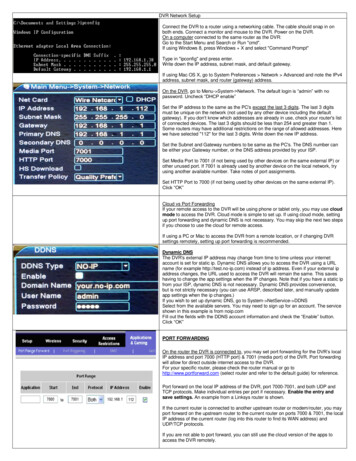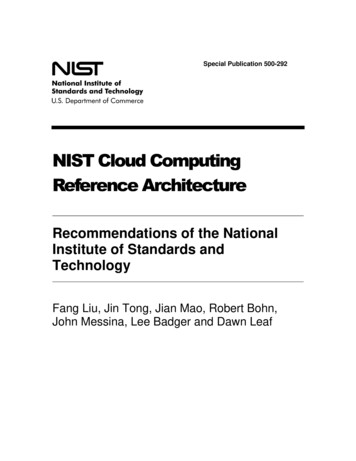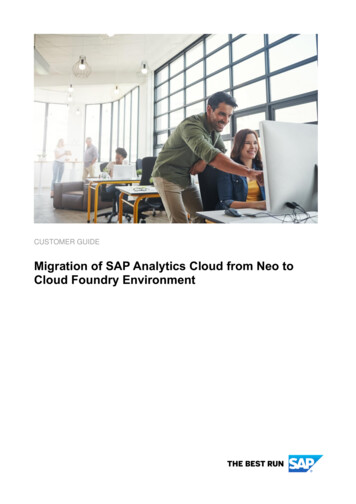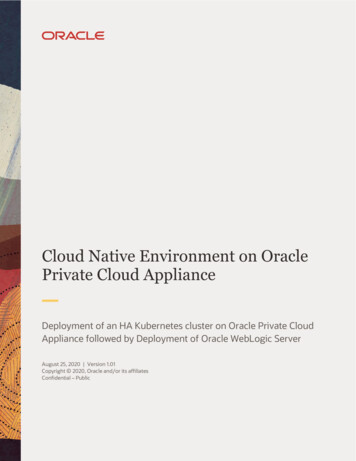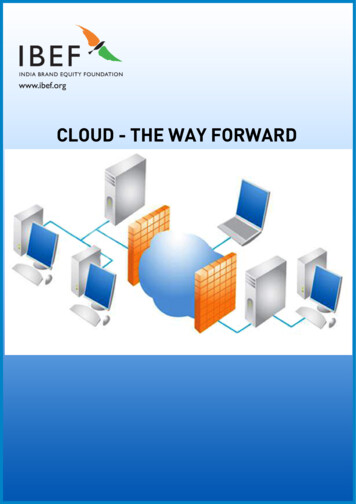
Transcription
CLOUD - THE WAY FORWARD
.CONTENTS1.IT INDUSTRY GOES THROUGH PERIODIC TRANSFORMATIONS . 42.CLOUD COMPUTING IS THE 4TH WAVE-A PERFECT STORM . 53.2.1Technology innovation . 52.2Delivery model innovation. 52.3Business model innovation . 6DEFINING THE CLOUD . 7Benefits . 73.14.LOT OF ACTION ON THE SUPPLY SIDE . 8Global trends . 84.15.CIOs INTEREST IS INCREASING EVERYDAY . 96.CLOUD REVOLUTION CAN POTENTIALLY BRING IN NEW COMPANIES FROM INDIA . 107.INDIAN COS. CAN POTENTIALLY DERIVE NEW USE CASES FOR CLOUD COMPUTING 127.1Cloud computing in India . 128.NOT JUST GLOBAL COMPANIES, INDIAN COMPANIES ARE INVESTING IN CLOUD . 139.A FEW INDIAN COMPANIES HAVE ALREADY BEEN ABLE TO COMPETE . 1410.CLOUD COMPUTING IS GOING TO BE ABOUT A LOT MORE THAN JUST COST. 15SAVINGS10.1Opportunities for Indian Market . 15
.CONTENTS11.INDIA HAS A LEGACY OF JUMPING THE TECHNOLOGY CURVE . 1612.BANKING INDUSTRY PRESENTS A HUGE POTENTIAL FOR CLOUD . 1813.EDUCATION SYSTEM IN INDIA COULD ALSO BE TRANSFORMED USING CLOUD . 1914.HEALTHCARE INDUSTRY IN INDIA DEMANDS END TO END INNOVATIONS . 2015.SMB SECTOR WOULD REQUIRE LOW COST SOLUTIONS TO ADDRESS UNIQUE. 21NEEDS16.GOVERNMENT WILL INCREASINGLY INVEST IN CLOUD FOR BETTER CITIZEN. 22SERVICES17.EVERY COMPANY HAS A KEY ROLE TO PLAY IN DRIVING THE INDIAN CLOUD. 23ECO-SYSTEM
.1.IT industry goes through periodic transformations The pace of innovation in the IT industry is always been faster compared toother industries and has resulted in the industry going through a series oftransformations over the last 50 years. It started with mainframecomputers than moved on to minicomputers, PCs and the web. Take the PC revolution for example. It put the power of computing in thehands of people. The smaller form factor and easy availability/usability ofsoftware led to the explosion in the number of PCs from 1.5 million PCs in1980s to over 1.5 billion PCs and net books in 2010. The internet had the same effect. The huge global information networkhelped create new use cases for IT in terms of Search, Collaboration,User-created content and entertainment. There were about 1. 4 billion newinternet users added just in the matter of last 10 years.3InternetRevolution2PCRevolution 1.8 billionInternetUsers 0.4 billionInternetUsers 1.5 billionPCs/ Laptops 1.5 millionPCs1MainframeRevolution 10,000MainframesA fewhundreds196019701980199020002010Cloud-The Way Forward4
.2.Cloud computing is the 4th wave-a perfect stormThe next wave of transformation in the IT industry is cloud computing. Thereare very few times in history such transformations happened. Many analystshave compared this to industrial revolution which helped improve productivityand standard of living more than any other time in history. This is a perfectstorm. It is a huge opportunity for companies. Let us understand why is it aperfect storm.2.1Technology innovationVirtualisation and Service oriented architecture/Web services are 2 keytechnology innovations of the last 10 years.Virtualisation technologies pioneered by companies such as VMware hashelped abstract the computing resources from the hardware. This has removedthe historical constraint of one server per application model and provided theability to run multiple virtual machines on a single physical machine. Thisabstraction has allowed companies to increase the through put of datacentersand forms an integral part of cloud computing.Service oriented architecture/Web services help organisations accessindependent building blocks over the internet for performing specific functions.This is independent of platforms and programming languages. If a companydoesn't like their existing business analytics tool they should be able to link upto another tool on the cloud for better results rather than spend a lot of timeand money for integration and implementation. This again forms the integralpart of cloud computing.2.2Delivery model innovationCloud computing has enabled an entirely new delivery model for software.Earlier companies had to invest millions of dollars in hardware infrastructure,software license and additionally for implementation. This made it prohibitivefor small and medium sized companies to leverage IT effectively. The cost of ITalso made large companies continue to use inefficient legacy technology. Cloudcomputing has changed all of this. It is today possible even for a small retailshop to access complex business analytics tools that were only available forlarge companies. In some way, the delivery model innovation brought in bycloud computing has created a business leveller between medium and largecompanies in certain industries.Cloud-The Way Forward5
.2.3Business model innovationCloud computing has also opened up a lot of possibilities in terms of businessmodel. It is identical to the shampoo sachet model to IT that will allowcustomers to pay for services and features that they use and also base it on timeor number of transactions and other similar models.Cloud computing has also allowed access of smaller Independent SoftwareVendors (ISVs) to customers that they never had through the use of marketplaces. This has allowed smaller ISVs to be based on cloud platforms (Such asAzure, App Engine etc.) and make themselves available to global customersthereby significantly reducing their cost of sales. This has also increased theflexibility for end customers and increased the choice of products and services.TechnologyinnovationDelivery ModelinnovationBusiness ModelinnovationCloud-The Way Forward6
.3.Defining the cloudDelivery Models in Cloud Computing3.1PublicCloud The cloud infrastructure is made available to the generalpublic or a large industry group and is owned by anorganisation selling cloud services.PrivateCloud The cloud infrastructure is operated solely for anorganisation. It may be managed by the organisation or athird party and may exist on premise or off premise.HybridCloud The cloud infrastructure is a composition of two or moreclouds (private, community, or public) that remain uniqueentities but are bound together by standardised orproprietary technology that enables data and applicationportability.BenefitsWhile there are multiple modes of delivery of cloud services such as privatecloud, public cloud or hybrid cloud, in totality, cloud offers a multitude ofbenefits. First of all it brings a "pay-as-you-go" flavour to the IT purchase inwhich low initial investments are required and one has to pay for what is beingused. Not only it is economical, but it also helps address the fluctuations in userload by providing elastic resources which can be scaled up and scaled downbased on the requirements. And this is achieved without having the need toadditionally invest in hardware and software to address the peak loads.One of the key benefits of cloud is its potential to offer rapid implementation inthe IT organisation. All one needs is connectivity and they are ready to go live.This completely eliminates the need of going through complex procurement andcertification processes.Cloud-The Way Forward7
.Cloud computing also offers consistent services and reliability and animmediate on time response to emergency situations.BenefitsCost EffectiveElasticFast ImplementationService Continuity4.Lot of action on the supply side4.1Global trends During any major market transition and transformational change, themarket opens up for a certain period and results in activities that can becompared to gold rush. The high interest among CIOs and enterprises has pushed the ITcompanies to go full fledged and adopt to cloud computing. Every large IT company across any part of the value chain, be it networkingcompanies, storage providers, operating systems vendors, middle wareproviders or business application vendors-everyone has a point of view oncloud computing. They want everyone to believe that their strategystatements have cloud in it. Massive investments in R&D.New partnerships and new competition.Large number of M&As related to cloud.Over 1500 start ups providing cloud productsand services.Software companies CEOs arebetting their jobs on cloud.Cloud-The Way Forward8
.Many of them have aggressively invested behind their cloud strategy and havedone massive acquisitions. This has also resulted in long term partners startingto compete with each other and vice versa. A few of the recent announcementsby large companies are a strong proof of the same: Cisco's entry into the server market to compete with HP directly. In response, HP has acquired 3COM and compete with Cisco. Microsoft's multi-billion dollar investments in R&D related to cloud. CISCO/EMC/VMware partnership for cloud infrastructure.It is evident that for most of these companies there is no looking back. They arebetting their entire companies on cloud.These changes will also impact the ISVs. If a few large IT companies startrunning the IT infrastructure for Fortune 500, then whom should the ISVs selltheir products to. Will they be forced to sell mainly to the large IT companies? Itremains to be seen.5.CIOs interest is increasing everydayDespite challenges and concerns, CIOs are also getting excited about theopportunities and benefits of cloud computing and related business models. In arecent survey done across 240 CIOs, more than 70% have said to favour cloudcomputing and will adopt to it in the near future.CIO Cloud Computing Survey (n 240 CIOs)27%Favouring CloudAdoptionNot on TechnologyRoad Map73%Cloud-The Way Forward9
.The reasons for this paradigm shift are obvious. Cloud computing brings in ahost of benefits to the CIOs. It reduces the capital investment required for IT deployment and providesscalability and flexibility to the CIOs. It also reduces the IT staff requirements to support and manage theinfrastructure. It also makes it easier for CIOs to view outsourcing a lot morestrategically rather than piece meal outsourcing of applicationdevelopment, maintenance etc. The business units also have better access to new features and industrybest practices as and when they are available rather than waiting for therelease of new versions of the product.Cloud Benefits6.Reduced Total Cost ofOwnershipReduced IT Staffing/Administration CostBetter IT and Line ofBusiness AlignmentIncreased Flexibility &On Demand ScalabilityFrequent SoftwareUpdatesBetter ProductivityCloud revolution can potentially bring in new companies from IndiaIndia was a silent spectator during the Mainframe and PC revolutions. We had afew local companies got created during those periods but none had majorimpact. However, it was not the case during the internet revolution. Riding on theback of the global internet infrastructure built during the dot com era, Indiancompanies who were focusing on sending consultants to work at the customersite in US on work visas realised that they can do a large part of the work fromCloud-The Way Forward10
.their offices in India. They invented the global delivery model and the rest ishistory. Y2K and the Internet revolution gave birth to global delivery models. Rise of multi billion dollar Indian IT service providers such as Infosys, TCS, Wipro. MNCs such as Accenture. IBM, etc. looked at service delivery from India.Infosys became a 5 billion dollar company in the span of 10 years. This not onlycreated a new business model but also forced existing IT consulting companiesto follow suit.Infosys Revenues ( 2009The same could happen with cloud. Cloud computing and the related businessmodels will become a leveller for Indian ISVs. There are no current market leaders incloud, the sales and marketing models for cloud are still evolving. More companiesare starting to use social media, online advertisement and telesales more to reach totheir customers. Most of these could be done out of India. We are already starting tosee signals of Indian start ups competing globally.Cloud-The Way Forward11
.7.Indian cos. can potentially derive new use cases for cloud computingTraditionalOpportunitiesSaaS enablementManaged ServicesCloud Opening upNew Avenues ofGrowthPlatform BPONon-LinearOpportunities7.1Cloud Based IPsCloud computing in IndiaCloud has not just opened up opportunities for Indian ISVs but also opened upinteresting opportunities for large services companies both for traditionalservices and services that will drive non-linear growth. In terms of traditionalopportunities, it has helped Indian services companies to get into areas such asSaaS enablement. Here they work with both the global ISVs who are moving intoSaaS as well as with enterprises who want to SaaS enable their traditionalapplications. Cloud models have also helped strengthen the managed servicescompetency of the Indian companies. Indian companies were traditionally goodin remote infrastructure management and were not keen on buying out thedatacenters of their customers. The global companies who were willing to takeup datacenters had a big upside in competitive scenarios. When cloud modelsget adopted by large companies, it will put Indian managed services companiesin a level playing field with their global competitors.Large IT companies in India all have over 100,000 engineers. It is scary to eventhink that they need to add another 100,000 engineers each to double theirrevenues. This has resulted in these companies looking for non-linear revenuemodels. Cloud based services provide perfect opportunity for these companies.Many of the Indian companies run the back office functions for their globalcustomers. They will use the cloud model to get into platform based servicesCloud-The Way Forward12
.such as the payroll services for example. In this model, each of the process theysupport their customer with have the capability to scale without adding too manypeople. Many companies are already investing in platform BPO services. They arealso starting to build their own cloud based IP that their customers can use.The global opportunity that has opened up for Indian companies is exciting. Thenext few years will be a great journey for all the companies and industry observers.8.Not just global companies, Indian companies are investing in cloudWiproCloud consulting, migration and managementSMB focused cloud productsAirtelPartnership with thin client providersAspiration to become CIO on the cloud8kmilesVirtual development environment on cloudCloud sourcing to solve SMB IT problemsZohoSaaS solutions to almost all IT application workloads.Out innovating global companiesMany of the Indian companies are creating cloud specific strategies as they see it asthe next enabler of growth. Many of the large sized Indian companies such asWipro, TCS, Infosys, Airtel and many others are betting big on cloud services. Aplethora of smaller companies are also starting to focus aggressively on cloudtechnologies. Close to 16% of all software product companies are already sellingone or more cloud based products in the domestic as well as global markets. Andsince cloud offers a level playing field (as it is a nascent phenomenon and evolvingtechnology), Indian companies such as Zoho have been able to compete againstsome of the large sized global companies in terms of selling SaaS/ cloud basedproducts in the market.Cloud-The Way Forward13
.Enterprise level cloud adoption by some of the large companies in India hasadded to the enthusiasm of these cloud vendors. Companies such as MaxHealthcare, Redbus, Dabur, Delhi Public School and many others are starting toadopt cloud based products & technologies and expect these investments towitness further growth in the years to come.9.A few Indian companies have already been able to competeInception Fundamental: A comprehensive offering to compete againstestablished players in a market opportunity of tens of billions of dollars in future.Indian SaaS companyNo venture funding400,000Desktops WinAgainst Google10 member team in SiliconValley600 developers/technicians inIndia2 Million Paid & UnpaidSubscribers TodayHires people from local colleges& schoolsAn interesting example is Zoho. Zoho is an Indian company started with nofunding and a small team in US. The entire engineering organisation is based outof Chennai. The company doesn't hire from large technology companies, largecompanies don't hire from them as well. Zoho trains and teaches students fromeconomically poor background, taps them at school leaving stage and trainsthem in their own in-house university.Cloud-The Way Forward14
.Zoho not only offers products that match the large companies feature to featurebut also at a very low cost as their operating costs are lower than the MNCs,though the MNCs also have development centres in India. Today Zoho has morethan 2 million users and most of its customers are SMBs with employeesbetween 40 to 200 employees.Recently GE evaluated various cloud application providers and selected Zohoover companies such as Google and deployed Zoho on over 400,000 desktops.This is a great example of how a small Indian company was able to win a contractfrom one of the largest companies in the world using the power of cloud.We all know that GE along with companies such as Citibank played a critical rolein building Indian services companies. This might happen again with cloud basedISVs.10.10.1Cloud computing is going to be about a lot more than just costsavingsOpportunities for Indian MarketThe Indian market is equally exciting if not more. The growth in IT spending isone of the fastest in the world. India is the world's fastest growing mobile market with over 20 millionsubscribers added every month. Mobile is going to be a key access devicefor cloud based products and services. The money companies invested for3G services showcased the belief that the large telecom providers have ondata services in the Indian market. Over 500 million people belong to the middle class in India. The productsand services consumed by them are relevant to other emerging marketsas well. This suggests that Indian customers are ideal for cloud offerings. Most of the manufacturing output (about 45%) comes from SMBs in India.Indian SMBs in specific lack budgets, want business improvement, lackmanagement bandwidth required to manage internal IT and all arelooking for rapid growth in the next few years.Cloud-The Way Forward15
.# of companies in Forbes 2000increasing by 23% every yearand will reach 162 by 2015Fastest growing mobile markets-20 mn additions per month500 million people in middleclass range earning in the rangeof 10,000 to 57,000 per yearSMBs account for 45% ofmanufacturing output and 47%of the total workforce11.India has a legacy of jumping the technology curveWireline & Wireless Penetration (in Million)600450300158281520150183134202003 (US)2003 (India)Wireline1292009 (US)372009 (India)WirelessCloud-The Way Forward16
.DTH Subscribers in India45Mn17Mn9Mn5Mn16%30%Share of DTH in total pay TVmarket volumes in India10%5%2007200820092014India has a legacy of jumping the technology curves, precedent exists in thetelecom sector and now DTH is also witnessing transformation. We anticipatethat cloud would show similar behaviour.Let us take the telecom sector as an example, in early 2000s, the wirelinesubscriber base was a significant chunk in the total subscriber base, whereasthe US, the trend was the movement to wireless mode of communication.However the actual growth in the telecom industry in India happened in 2005onwards and subscribers did not go through the typical adoption of wireline firstand then move to wireless, instead they straight away started with wireless.There is a high chance that companies that are not adopting IT today and don'thave major investments in datacenters and server farms will directly move intothe cloud model. There are ample opportunities in every industry. Be it retail,manufacturing, banking, education or government. The key themes for most ofthe opportunities are cloud, mobile, market place, price discovery, collaborationand analytics.Cloud-The Way Forward17
.The other key is to look at the ecosystem as a whole and partner with variousproviders to address the opportunities rather than try to address itindependently.12.Banking industry presents a huge potential for cloudCurrent banking penetration in India is 35%75 banks with 80,000 branchesand 400 Mn accountsFinancial inclusion to enableincreased access to the currentlyexcluded populationHuge CostHuge BaseSME banks can leverage cloud technologies todeliver better banking servicesInternet BankingMobile BankingMicro FinanceThe current banking penetration in India is only 35%. The large public andprivate banks are growing rapidly. Large banks such as ICICI bank already havebest-in-class IT deployments. In many cases they have built their ownapplications to solve India specific problems. Government is increasing theirfocus on financial inclusion. Corporate banks and the local chit funds also makeup a key part of the banking ecosystem in India.Even for the large banks, the cost of reaching to the "Bottom of the Pyramid" isprohibitively high and are partnering with Microfinance institutions to reachthem. The smaller banks are still to enable their services on the internet, Mobilebanking is still a tip in the iceberg.Microfinance is an interesting model as it is based on self-help groups wherepeople from each of the group should be in physical proximity. Can social mediaand collaboration models made possible by cloud solutions create newdisruptions in the microfinance models and thereby improve financial inclusionin India. It will be an interesting opportunity for a start up company to explore!Cloud-The Way Forward18
.13.Education system in India could also be transformed using cloudCurrent allocated expenditure for education is 4% of the GDP 400/ student in India ascompared to 10,000 in USRight to education act to ensureeducation to allHuge CostLow SpendCloud can potentially help revolutionise theeducation system in IndiaOnline EducationTeacher PupilEnablementSchoolManagementEducation industry can also be transformed using cloud solutions. India currentlyspends 400/student compared to the 10,000/student in the US. We spendaround 4% of the GDP on education services. With the right to Education Bill,there will be a lot of pressure on the government to increase the expenditure oneducation. Similar to healthcare, the current model will become cost prohibitive.There are tremendous opportunities for IT in education in India in terms of onlineeducation, teacher training/enablement and school management. A fewcompanies are starting to work on some of these areas and have already startedto see success.SchoolMATE [School Management AT Ease] is a CRM (Customer RelationshipManagement) ERP (Enterprise Resource Planning) software for EducationalInstitutions. SchoolMATE helps schools in continuously updating parents abouttheir child's status and his performance at school over their mobile phonesthrough text messages (SMS) and also through e-mail and Web using a securemechanism.Cloud-The Way Forward19
.The innovation from SchoolMate is to provide the entire product as a service.They figured out that even if they provide the solution on the cloud, there issomeone in the school who needs to enter the information into the computer andit was difficult for the school to train the teachers to be able to do this. So alongwith the software, SchoolMate provides the data entry provider. This way theteachers don't have to change their current way of working.The business model is to charge the parents and not the school. The parents arewilling to pay for this service as they get to know about their children in real time.Today SchoolMATE has over 70,000 parents enrolled into this programme.14.Healthcare industry in India demands end to end innovationsCurrent allocated expenditure for healthcare is 5.2% of the GDP50% population with no access toprimary healthcareHealthcare expenditure toincrease 5 folds to match globalstandardsHuge CostHuge BaseIndustry needs fundamental innovations to sufficeneeds-cloud can potentially helpTelemedicinePatient RecordsHospitalProductivityLet us look at Healthcare. India spends around 5.2% of the GDP on healthcare.Even at this level of spending 50% of the people don't have access to healthcare. IfIndia has to provide health care in terms of global standards, it would have tospend 5 times more than the current spend. Even US spends only 16% of the GDPon healthcare. So the current model of providing healthcare is just not going toscale to suffice the need to provide universal healthcare in India. The industryneeds to look at fundamental ground up innovations to reduce the cost ofhealthcare. The innovation needs to happen in a number of areas starting frommedical education, medical devices etc. IT can play a key role in some parts of thevalue chain such as hospital productivity, telemedicine and patient records. Alreadycompanies such as Wipro have created India specific healthcare IT solutions.Cloud-The Way Forward20
.15.SMB sector would require low cost solutions to address uniqueneedsInception Fundamental: To create a "NANO" in ITDriven By Ratan TataValue PropositionCustomer BehaviorComplexity of ITReachBusiness ModelImpactITaaS StackBusiness IntelligenceCustom ApplicationsBusiness ApplicationsEmail, Office AppsNetworking EquipHardwareCloud-The Way Forward21
.45% of the manufacturing output in India is from SMBs. The existing ERPsolutions designed for large companies don't work for SMBs. They are difficult touse, are not customised for the SMBs needs and are cost prohibitive to buy,deploy and maintain.An interesting example is TCS who were aggressive enough to leverage the SMBopportunity. It is believed that Ratan Tata wanted to create an IT Nano for theSMBs in India. The TCS team went into action and met with many SMBs acrossIndia to understand the pain points and requirements. They found out that manyof the SMBs had bought some solution but are not using them as they were notsolving their pain area. Many found that they don't need all the complex featuresand the products were unnecessarily complicating their processes.TCS invested in a large team to build a solution specifically focused on SMBs a
Cloud-The Way Forward 7. 3. Defining the cloud. Delivery Models in Cloud Computing . Public Cloud. Private Cloud. Hybrid Cloud · The cloud infrastructure is made available to the general public or a large industry group and is owned by a


